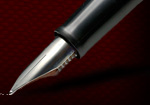Other Work
Columbia's 'Smoking Gun' Was Obscured;
NASA Did Not See a Deadly Risk When Foam Struck Shuttle Wing
By Kathy Sawyer
The Washington Post | Sunday, August 24, 2003; Page A01
An account of the space shuttle Columbia failure, published just before the release of the accident investigation report. For complete article, and related links, see: http://cti.itc.virginia.edu/~meg3c/Columbia/Columbia.html
Nobody saw the "smoking gun" when it fired, 81 seconds after the space shuttle Columbia lifted off from its Cape Canaveral launch pad on Jan. 16.
The shuttle was over the Atlantic Ocean, racing skyward at more than 1,600 mph -- greater than twice the speed of sound -- as it climbed through an altitude of 66,000 feet in the thinning air. A ragged section of insulating foam -- a Styrofoam-like slab weighing almost two pounds and about the size of a flat-screen TV -- flew off the shuttle's 15-story-tall, bullet-shaped propellant tank.
The fragment hit the roiling supersonic air stream like a Styrofoam cup tossed from a racing car, slowed abruptly and started spinning rapidly as it traveled about 60 feet. In a split second, it struck the leading edge of the left wing at a relative velocity of 530 mph. Two smaller foam chunks that broke off at the same time missed the wing.
Even though it seemed insubstantial, the foam Frisbee, traveling at that velocity and spinning at least 18 times a second, struck with about a ton of force. It was simple physics. The impact blew a hole probably six to 10 inches across in the leading edge of the left wing.
While most of the ingredients of Columbia's destruction had been collecting for some time, tucked away in the crannies of a complicated bureaucracy, no one had seen them, either. In contrast to the 1986 loss of the shuttle Challenger, when engineers had tried to stop the launch only to be overruled by higher-ups, this time the portents had become invisible to all those who might have altered events.
The catastrophe that had begun over the Atlantic, dooming Columbia and its seven astronauts, would not unfold for 16 more days -- also mostly out of sight.
It would take armies of engineers and six months of arduous detective work to bring into focus what had gone wrong on Feb. 1, not only with the shuttle but with the organization that had sent it on its way.
The following is an account of what most likely happened to Columbia, based largely on the results of that effort -- official records, transcripts and video from NASA and the Columbia Accident Investigation Board, including Freedom of Information Act releases and engineering test results and analyses -- and interviews. The probe will culminate this week when the independent board releases its final report exposing in detail the roots of the tragedy.
Until the end, Columbia's mission would seem as close to perfect as the risky business of flying into space ever gets.
A Haunted Moment
As the main engines ignited, the astronauts heard a crack followed by a muffled roar and felt the vibrations as their 4.5-million-pound craft started skyward, riding a controlled explosion. It was 10:39 a.m. on Jan. 16.
The launch is the tensest part of any mission. Still, Cmdr. Rick Husband, 45, a colonel in the Air Force who was strapped into the front left seat, took note of the brilliant sunlight streaming in the overhead windows, the shadows moving over the control panels as the shuttle rolled onto its back.
"Columbia, Houston. You're go at throttle up," came the call from mission control in Houston, 70 seconds after liftoff.
"We copy, go at throttle up," responded Husband, a former test pilot who had flown an earlier shuttle mission. That phrase -- and that moment in the shuttle's fiery ascent -- had been haunted for 17 years. This was the point at which Challenger had exploded, etching America's first in-flight space disaster in sudden fire and smoke across another January sky, 88 shuttle missions earlier.
The commander's acknowledgement of a routine power adjustment came just after the spaceship had broken the sound barrier.
This time, another 10 seconds passed before the trouble started, unheeded. The errant foam projectile broke a hole in the crucial material known as RCC, for Reinforced Carbon Carbon, a tough material that was supposed to protect key surfaces from the lethal heating that occurred when the space plane reentered Earth's atmosphere at more than 24 times the speed of sound.
At the time the foam struck, there was still time for the shuttle to abort its ascent and make an emergency landing -- a risky move that no shuttle has ever attempted. But the shuttle, although intently monitored during its ascent, had no instruments to immediately detect the fatal blow.
Another day would pass before engineers discovered the impact in a blurry video of the launch. And even then, no one would appreciate its dire implications. . . .


